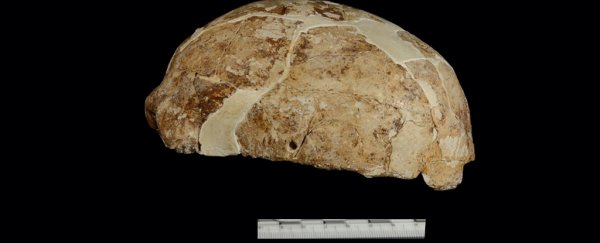Remains recovered from a cave in the Chinese province of Yunnan more than 10 years ago have finally given up their secrets, with a DNA analysis revealing not just who left them, but ultimately where their ancestors would go.
Researchers from the Chinese Academy of Sciences evaluated nuclear and mitochondrial sequences extracted from a 14,000-year-old skull, discovering the woman it once belonged to – dubbed Mengzi Ren – was closely related to populations who would eventually be the first to set foot in the Americas.
Since their discovery in 2008, the dozens of late Paleolithic human bones left behind in Malu Dong (Red Deer Cave) in China's south-west have left anthropologists scratching their heads over just who they might have belonged to.
Without sufficient collagen to base a carbon dating analysis on, their age can only be estimated from surrounding features of their grave site. It's not even clear if the mix of bones that includes a skull fragment and the top end of a femur all come from the same individual.
What is clear is whoever left them behind represented a unique mix of archaic and modern characteristics.
Maybe, not unlike the more ancient populations of Homo floresiensis, they were a holdout ancestral human clinging to survival in Asia's south east. Or perhaps they were a hybrid mix of much older humans and a more modern population.
It's also possible a few ancestral traits had simply stuck around in their genes, in spite of thousands of years of evolution.
To find exactly where Mengzi Ren sat in our sprawling family tree, the researchers sequenced what DNA they could extract, mapped it according to a standard genomic reference model.
Since mitochondrial DNA is only passed down through the egg from a mother, they could identify her matriarchal lineage as a now-extinct branch that is now represented by just two modern day sub-populations.
A close look at her nuclear DNA verified Megzi Ren's close ties with anatomically modern humans, all but ruling out her heritage among a more ancient stock.
"Ancient DNA technique is a really powerful tool," says Bing Su, an archaeologist with the Chinese Academy of Sciences.
"It tells us quite definitively that the Red Deer Cave people were modern humans instead of an archaic species, such as Neanderthals or Denisovans, despite their unusual morphological features."
Although Mengzi Ren is more closely related to today's southern Chinese populations than those in the north, she has less in common with people who now live across Asia's southeast, suggesting there were already well structured, diversified populations in the region thousands of years ago.
That's not to say Asia was populated from the bottom up. There's strong evidence that a relatively small population of humans also ventured down from the north to settle the east, a group that would split to venture across the ice-covered stretch of the Bering Strait to settle the vast wilderness of the Americas.
Linking Mengzi Ren's DNA with sequences from this northern population means there is now strong evidence of ties between not just modern Asian populations and America's First Nations, but ancient Asian lineages as well.
"Such data will not only help us paint a more complete picture of how our ancestors migrate but also contain important information about how humans change their physical appearance by adapting to local environments over time, such as the variations in skin color in response to changes in sunlight exposure," says Su.
If all goes to plan, Mingzi Ren won't be alone in having her genes deciphered. Not only does Red Deer Cave have more secrets to reveal, but so do plenty of other Late Pleistocene sites across Asia.
Within those bones we'll no doubt uncover more details of how today's human population traveled, settled, and explored every inch of our planet.
This research was published in Current Biology.
